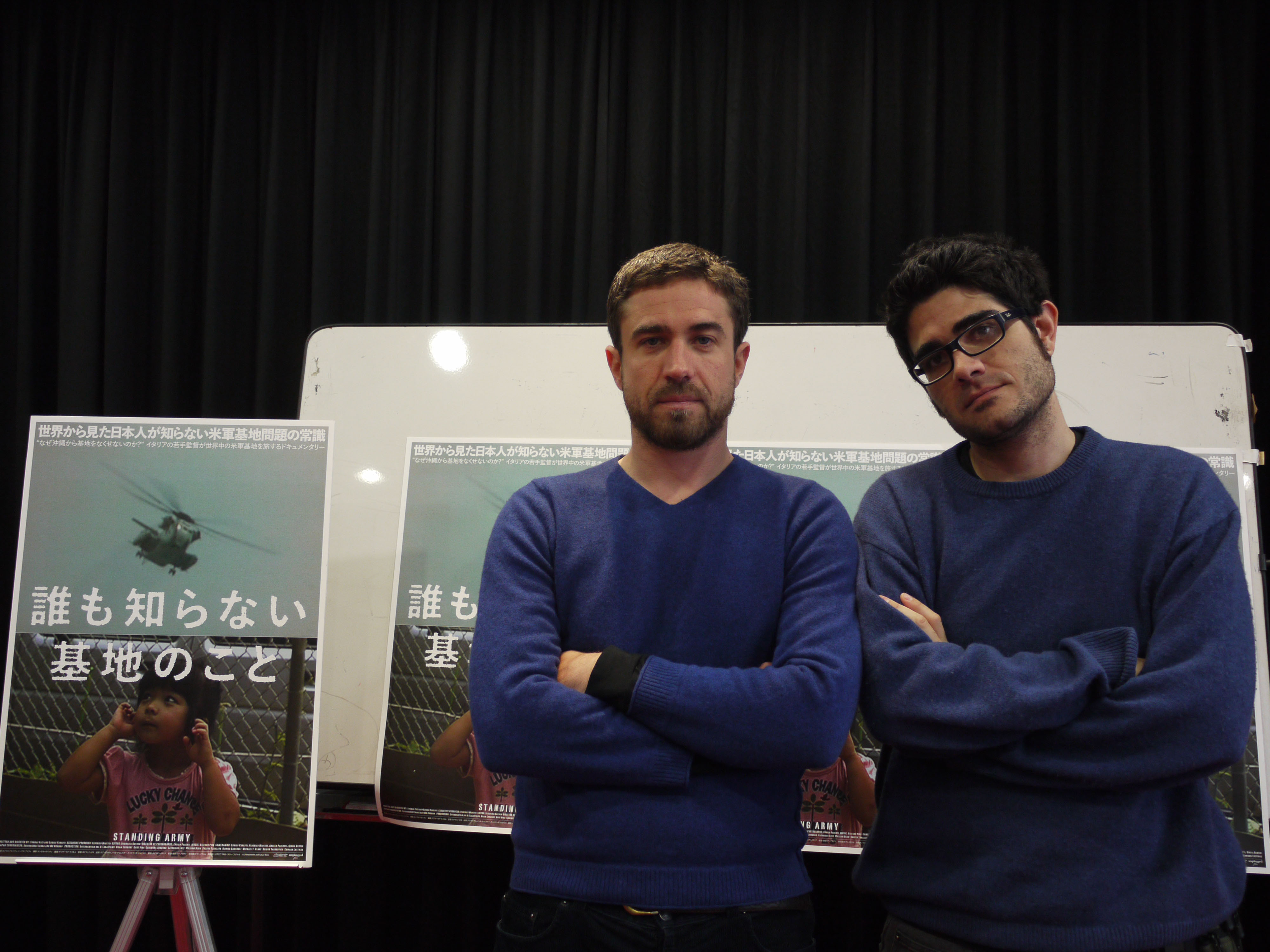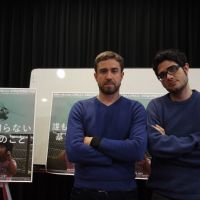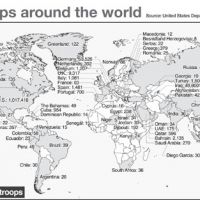Complex issues often become much easier to understand when they are approached with the benefit of a broader perspective.
A new documentary film on U.S. military bases worldwide is a perfect example of this, as its global perspective helps shed particular light on the conflicted current base issues in Okinawa — especially the political deadlock over the relocation of U.S. Marine Corps Air Station Futenma at Ginowan, just outside the prefectural capital of Naha.
It also explains, with amazing clarity, why the number of U.S. military bases around the world keeps on rising — often overriding opposition from affected communities.
Fittingly, for the two young Italian directors of the film, titled "Standing Army," the whole grand project grew out of their interest in a particular local issue — the proposed expansion in 2007 of a U.S. Army base in Vicenza, northeast Italy, that provoked street demonstrations and a massive public outcry.
Talking to protesters in the picturesque historic city that was made a UNESCO World Heritage Site dubbed "City of Palladio" in 1994, the two, who live in Rome, said they soon realized that the problem extended far beyond Vicenza.
"We discovered through activists in Vicenza that bases were a much bigger issue than we had thought," recalled co-director Enrico Parenti, 33, during a visit to Tokyo earlier this month along with fellow co-director Thomas Fazi, 29. "So we decided to do a reportage on the Vicenza and Italian bases, but we slowly discovered that we couldn't do justice to the subject by only talking about Vicenza."
As a result, the 74-minute movie starts with a catalogue of alarming statistics drawn from the public domain: the United States, long after the Berlin Wall came down in 1989 and the Cold War ended with the collapse of the Soviet Union two years later, boasts 716 military bases in 38 countries around the world — with 250,000 troops deployed at them as a permanent "standing army" even in times of peace.
Next, the directors zoom in on the grief of former residents of the British Indian Ocean Territory of Diego Garcia, all of whose population of 2,000 were expelled and relocated to the United Kingdom, the Seychelles and Mauritius when the British government allowed the island to be converted to a U.S. base in 1971.
Then as the film moves on, the story of the more than six decades of U.S. military presence in Okinawa comes under the spotlight. Residents of Ginowan City, a large part of which is occupied by the Futenma base, tell them that the runways for U.S. warplanes are so close to their homes and schools that they can see the faces of pilots flying overhead. Not only do they have to put up with the planes' noise day in and day out, they say they must also live with the fear of disaster, such as the one in 2004 when a helicopter crashed in a residential area of the city.
The movie also incorporates plenty of insight and historical background provided by some of the greatest contemporary American intellectuals, including Chalmers Johnson, Noam Chomsky and Gore Vidal.
Johnson, in an interview filmed before his death in November 2010, said that since the collapse of the Soviet Union, the U.S. has found itself in need of "new enemies" — a need it constantly satisfied by waging wars on drugs, on terror and even on "uncertainty." Thus the bases have come to be the "unit" for the postwar American empire, Johnson charged, just as colonies used to be the unit for European nations' empires.
Vidal, meanwhile, points out that this ever-expanding worldwide network of bases gives the U.S. "the means of perpetual war." As he says to camera in the film: "Perpetual war for perpetual peace being the American dream, once we launch the empire we'll never look back. And we'll always find a pretext to attack an enemy."
But it didn't all happen overnight. We learn, from news footage included in the film of the 1961 farewell address by outgoing U.S. President Dwight D. Eisenhower, how the former U.S. Army general momentously coined a new phrase when he warned of excessive influence by "the military-industrial complex" — a profit-driven weapons and equipment nexus involving the Pentagon, legislators, lobbyists and defense contractors. It was a warning that has gone largely unheeded.
U.S. bases — put into perspective this way — suddenly start to look like eerie and unwarranted alien presences, though the PR officer for Camp Bondsteel in Kosovo seemed oblivious of the filmmakers' intensions as he happily showed them around the base in 2008.
Fazi admits that the two went there around February 2008 "under the pretense" of doing a reportage on Kosovo's declaration of independence that month — which purportedly marked an end to decades of armed conflict between Bosnia's Muslims and Serbs. The base, where thousands of U.S. troops are stationed, has a movie theater, an All-American cafeteria, an Internet room and a brand new gym. It even has a room where off-duty soldiers can play video games. The camera captures a soldier engaging in a shooting war game — as a recreational activity.
"They play at war in their free time," Parenti says. "The (PR) guy didn't have any idea about the paradox."
The filmmakers freely admitted they had anti-base feelings from the very beginning. "In Japan, the official pretext (for the U.S. bases) is the North Korea situation, which I guess is very debatable, but at least it's there — and it's easy to use it as an obvious scarecrow," Fazi said.
"But in Italy's case, I mean, it doesn't make any sense. The base in Italy can only be used to attack other countries. And I think almost everyone in Italy understood that. That's why more than 100,000 people marched in the streets (in protest)."
But isn't it true that at least some people in the host countries have mixed feelings on the bases, because they are dependent on them economically?
Fazi scoffs at the idea that the locals in Okinawa, for one, need the U.S. bases for economic reasons. "The economic argument is very very weak," the half-British Fazi, who works as a political consultant in Rome, said. "Okinawa is a beautiful island. If the bases were used for tourism purposes they would make much more money. It's an obvious solution — turn the bases into resorts. This economic argument has always been used throughout history."
In fact, Fazi continued, there are many cases of U.S. bases being converted for civil uses in Germany "with great success" — noting that closed bases have been turned into arts and culture centers.
"Germany used to have many more bases than it does now. When bases closed down they were turned into all kinds of (places) — which brought much more to communities. Right now the bases are the obvious obstacles to the development of Okinawa."
What, then, can each of us do to change the status quo — and remove bases from where most locals don't want them?
The filmmakers say taking action is actually not that difficult. For them, that action was to make a film on the issue for an international audience.
"Our case is symbolic in a way; I was 29 years old when I started and he (Fazi) was 25. We didn't have any money," Parenti said, noting that the film took three years to complete because the two financed it entirely out of their own pockets.
"We were able to make this movie because we had the Internet, so we could do research; we had cheap cameras to film with; and we had a bit of knowledge and knowhow regarding filmmaking. And then when we started contacting people (we found that) everyone is willing to help you. We had a lot of help everywhere we went to — from Okinawa to Vicenza, and from intellectuals in America to intellectuals in Italy.
"In the end it's easy, as all you have to do is put pieces of the web together. Once we started, it was like a snowballing effect."
"Standing Army" — narrated in English — is showing at Image Forum in Tokyo's Shibuya Ward through May 11. It will then be screened across the country. For details, call the theater at (03) 5766-0114 or visit kichimondai.com (Japanese only).




















With your current subscription plan you can comment on stories. However, before writing your first comment, please create a display name in the Profile section of your subscriber account page.